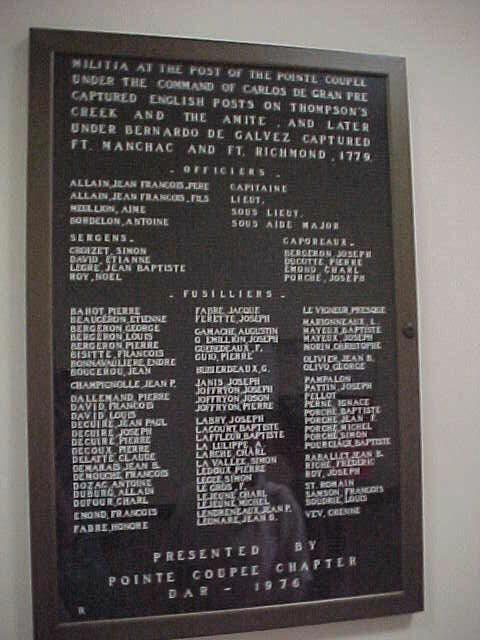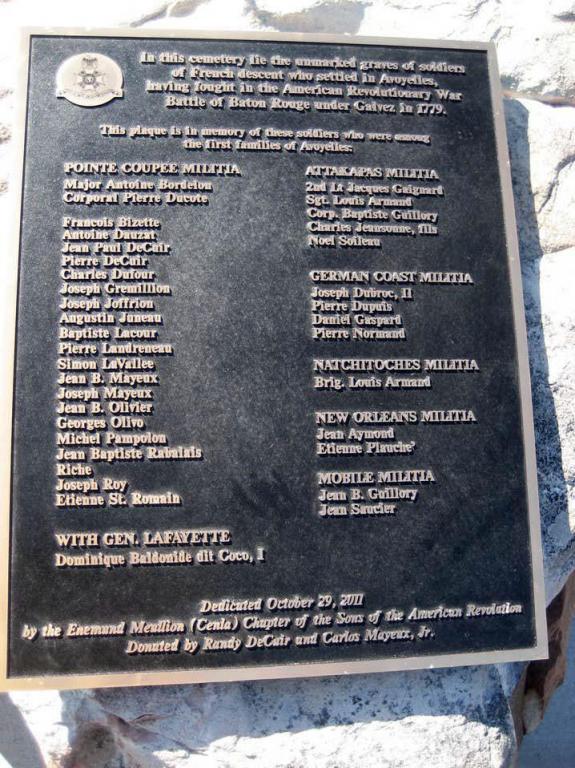Charles DUFOUR
SAR Patriot #:
P-150868
The following information was assembled from numerous sources and cannot be used directly as proof of Qualifying Service or Lineage.
It is considered a research aid and is intended to assist in locating sources that can be used as proof.
State of Service: ESP
Qualifying Service: Patriotic Service
DAR #: A034412
Birth: abt 1756 Arkansas River / / AR
Death: bef 31 Mar 1809 / Pointe Coupee Parish / LA
Qualifying Service Description:
A fusilier in the Company of the Militia for Pointe Coupee Post of Louisiana serving under Bernardo de Galvez during the Baton Rouge campaign
Additional References:
- Louisiana Patriots, 1776-1783. Elizabeth Whitman Schmidt, compiler. DAR. 1994
- DeVille, Winston. "Louisiana Soldiers in the American Revolution." Ville Platte, LA: 1991, pg 32
- Schmidt, Elizabeth Whitman. “Louisiana Patriots, 1776-1783. “ Washington, DC; National Society, Daughters of the American Revolution, 1994, pg 17
- Churchill, Charles Robert. “Bernardo de Galvez: Services to the American Revolution.” Louisiana Society, Sons of the American Revolution, 1925, pg 330
- "1770 Militia Rosters for the Acadian Coast and Pointe Coupee." Papeles Procedentes de Cuba, edición 141, legajo 161A, folio 13; Archivo General de Indias, Seville, Spain
- Granville W. & N.C. Hough. “ Spain’s Louisiana Patriots in its 1779-1783 War with England during the American Revolution.” Pt. 6, 2000. Laguna Hills, Ca: GW & NC Hough, pg 72
Spouse: Adrienne Deshotels
Children: Charles;
Members Who Share This Ancestor
| Date Approved | Society | ACN | SAR Member Info | Lineage via Child | View Application Detail | |
|---|---|---|---|---|---|---|
| 1991-10-23 | TX | 215697 | David Lacey Garrison Jr (137094) | Heloise | ||
| 1994-08-25 | TX | 212553 | James Gardiner Garrison (139524) | Heloise | ||
| 2017-04-21 | TX | 72738 | David Lee Peavy (194635) | Heloise/Eloyisa | ||
| 2024-10-04 | TX | 112991 | Stephen Wayne Dufour (231259) | |||
| 2025-01-17 | WA | 110335 | Jerry Michael Bordelon (206717) | Valery | ||
| 2025-03-07 | TX | 115470 | Hudson Dean Dufour (232855) |
Location:
Pointe Coupee / Pointe Coupee Parish / LA / USA
Find A Grave Cemetery #:
Marker Type:
SAR Plaque / DAR Plaque
SAR Grave Dedication Date:
29 Oct 2011
Comments:
- On 29 October 2011, the Enenomd Meullion (Cenla) NSSAR Chapter dedicated a plaque at the St. Paul the Apostle cemetery in Mansura, Avoyelles, LA. The plaque is a memorial to those soldiers who served in the militias of Pointe Coupee, Attakapas, Natchitoches, New Orleans, Mobile, and the German Coast. Charles Dufour is listed as on the memorial plaque as a member of the Pointe Coupee militia
- The marker is located at: St. Paul the Apostle Catholic Cemetery, Little Cemetery Rd., Mansura, LA 71350 (Lat: 31.08157, Long: -92.04408)
- The Pointe Coupee NSDAR chapter held a ceremony on 16 May 1976, honoring some of the Pointe Coupee militiamen. A plaque was hung in the Pointe Coupee courthouse listing the soldiers, including Charles DuFour. (See: "Pointe Coupee's Patriots." (2016))
- Photos displayed courtesy of David L. Peavy, TXSSAR
Directions to Cemetery / Gravesite:
In 1739, the original St. Francis Church of Pointe Coupee was dedicated along the Mississippi river. It was later destroyed during a storm. The second St. Francis church was built in 1760. Attached to the church was the cemetery. Over the course of more than a hundred years, the Mississippi river slowly eroded the cemetery. After the 1890 great flood, the cemetery and the church site were located on the bed of the Mississippi river. The second church was dismantled in 1891 and construction on the third church was begun in 1894

